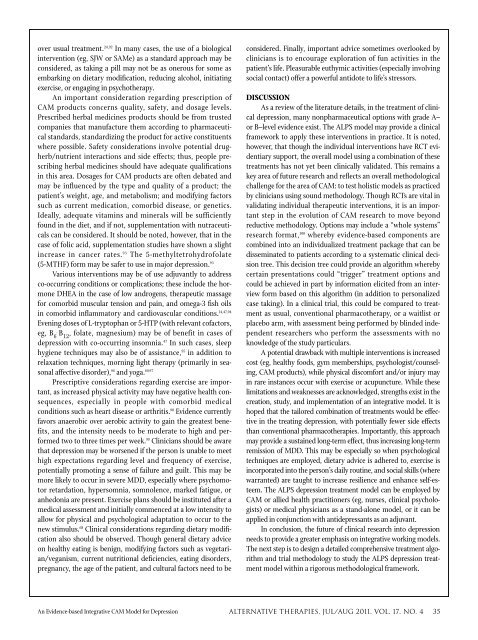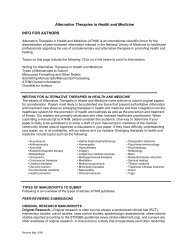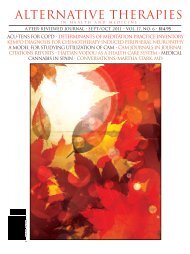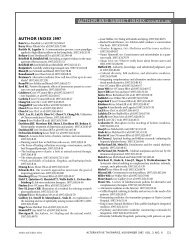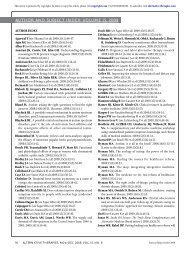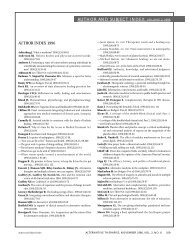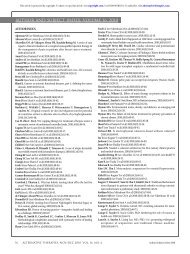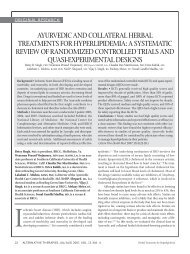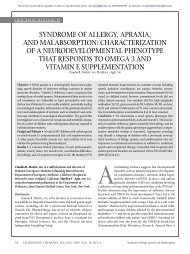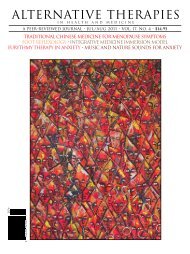Alternative Therapies In Health And Medicine
Alternative Therapies In Health And Medicine
Alternative Therapies In Health And Medicine
Create successful ePaper yourself
Turn your PDF publications into a flip-book with our unique Google optimized e-Paper software.
over usual treatment. 24,92 <strong>In</strong> many cases, the use of a biological<br />
intervention (eg, SJW or SAMe) as a standard approach may be<br />
considered, as taking a pill may not be as onerous for some as<br />
embarking on dietary modification, reducing alcohol, initiating<br />
exercise, or engaging in psychotherapy.<br />
An important consideration regarding prescription of<br />
CAM products concerns quality, safety, and dosage levels.<br />
Prescribed herbal medicines products should be from trusted<br />
companies that manufacture them according to pharmaceutical<br />
standards, standardizing the product for active constituents<br />
where possible. Safety considerations involve potential drugherb/nutrient<br />
interactions and side effects; thus, people prescribing<br />
herbal medicines should have adequate qualifications<br />
in this area. Dosages for CAM products are often debated and<br />
may be influenced by the type and quality of a product; the<br />
patient’s weight, age, and metabolism; and modifying factors<br />
such as current medication, comorbid disease, or genetics.<br />
Ideally, adequate vitamins and minerals will be sufficiently<br />
found in the diet, and if not, supplementation with nutraceuticals<br />
can be considered. It should be noted, however, that in the<br />
case of folic acid, supplementation studies have shown a slight<br />
increase in cancer rates. 93 The 5-methyltetrohydrofolate<br />
(5-MTHF) form may be safer to use in major depression. 93<br />
Various interventions may be of use adjuvantly to address<br />
co-occurring conditions or complications; these include the hormone<br />
DHEA in the case of low androgens, therapeutic massage<br />
for comorbid muscular tension and pain, and omega-3 fish oils<br />
in comorbid inflammatory and cardiovascular conditions. 14,47,94<br />
Evening doses of L-tryptophan or 5-HTP (with relevant cofactors,<br />
eg, B 6<br />
,<br />
B 12<br />
, folate, magnesium) may be of benefit in cases of<br />
depression with co-occurring insomnia. 47 <strong>In</strong> such cases, sleep<br />
hygiene techniques may also be of assistance, 95 in addition to<br />
relaxation techniques, morning light therapy (primarily in seasonal<br />
affective disorder), 96 and yoga. 69,97<br />
Prescriptive considerations regarding exercise are important,<br />
as increased physical activity may have negative health consequences,<br />
especially in people with comorbid medical<br />
conditions such as heart disease or arthritis. 98 Evidence currently<br />
favors anaerobic over aerobic activity to gain the greatest benefits,<br />
and the intensity needs to be moderate to high and performed<br />
two to three times per week. 99 Clinicians should be aware<br />
that depression may be worsened if the person is unable to meet<br />
high expectations regarding level and frequency of exercise,<br />
potentially promoting a sense of failure and guilt. This may be<br />
more likely to occur in severe MDD, especially where psychomotor<br />
retardation, hypersomnia, somnolence, marked fatigue, or<br />
anhedonia are present. Exercise plans should be instituted after a<br />
medical assessment and initially commenced at a low intensity to<br />
allow for physical and psychological adaptation to occur to the<br />
new stimulus. 68 Clinical considerations regarding dietary modification<br />
also should be observed. Though general dietary advice<br />
on healthy eating is benign, modifying factors such as vegetarian/veganism,<br />
current nutritional deficiencies, eating disorders,<br />
pregnancy, the age of the patient, and cultural factors need to be<br />
considered. Finally, important advice sometimes overlooked by<br />
clinicians is to encourage exploration of fun activities in the<br />
patient’s life. Pleasurable euthymic activities (especially involving<br />
social contact) offer a powerful antidote to life’s stressors.<br />
Discussion<br />
As a review of the literature details, in the treatment of clinical<br />
depression, many nonpharmaceutical options with grade A–<br />
or B–level evidence exist. The ALPS model may provide a clinical<br />
framework to apply these interventions in practice. It is noted,<br />
however, that though the individual interventions have RCT evidentiary<br />
support, the overall model using a combination of these<br />
treatments has not yet been clinically validated. This remains a<br />
key area of future research and reflects an overall methodological<br />
challenge for the area of CAM: to test holistic models as practiced<br />
by clinicians using sound methodology. Though RCTs are vital in<br />
validating individual therapeutic interventions, it is an important<br />
step in the evolution of CAM research to move beyond<br />
reductive methodology. Options may include a “whole systems”<br />
research format, 100 whereby evidence-based components are<br />
combined into an individualized treatment package that can be<br />
disseminated to patients according to a systematic clinical decision<br />
tree. This decision tree could provide an algorithm whereby<br />
certain presentations could “trigger” treatment options and<br />
could be achieved in part by information elicited from an interview<br />
form based on this algorithm (in addition to personalized<br />
case taking). <strong>In</strong> a clinical trial, this could be compared to treatment<br />
as usual, conventional pharmacotherapy, or a waitlist or<br />
placebo arm, with assessment being performed by blinded independent<br />
researchers who perform the assessments with no<br />
knowledge of the study particulars.<br />
A potential drawback with multiple interventions is increased<br />
cost (eg, healthy foods, gym memberships, psychologist/counseling,<br />
CAM products), while physical discomfort and/or injury may<br />
in rare instances occur with exercise or acupuncture. While these<br />
limitations and weaknesses are acknowledged, strengths exist in the<br />
creation, study, and implementation of an integrative model. It is<br />
hoped that the tailored combination of treatments would be effective<br />
in the treating depression, with potentially fewer side effects<br />
than conventional pharmacotherapies. Importantly, this approach<br />
may provide a sustained long-term effect, thus increasing long-term<br />
remission of MDD. This may be especially so when psychological<br />
techniques are employed, dietary advice is adhered to, exercise is<br />
incorporated into the person’s daily routine, and social skills (where<br />
warranted) are taught to increase resilience and enhance self-esteem.<br />
The ALPS depression treatment model can be employed by<br />
CAM or allied health practitioners (eg, nurses, clinical psychologists)<br />
or medical physicians as a stand-alone model, or it can be<br />
applied in conjunction with antidepressants as an adjuvant.<br />
<strong>In</strong> conclusion, the future of clinical research into depression<br />
needs to provide a greater emphasis on integrative working models.<br />
The next step is to design a detailed comprehensive treatment algorithm<br />
and trial methodology to study the ALPS depression treatment<br />
model within a rigorous methodological framework.<br />
An Evidence-based <strong>In</strong>tegrative CAM Model for Depression<br />
ALTERNATIVE THERAPIES, jul/aug 2011, VOL. 17, NO. 4 35


